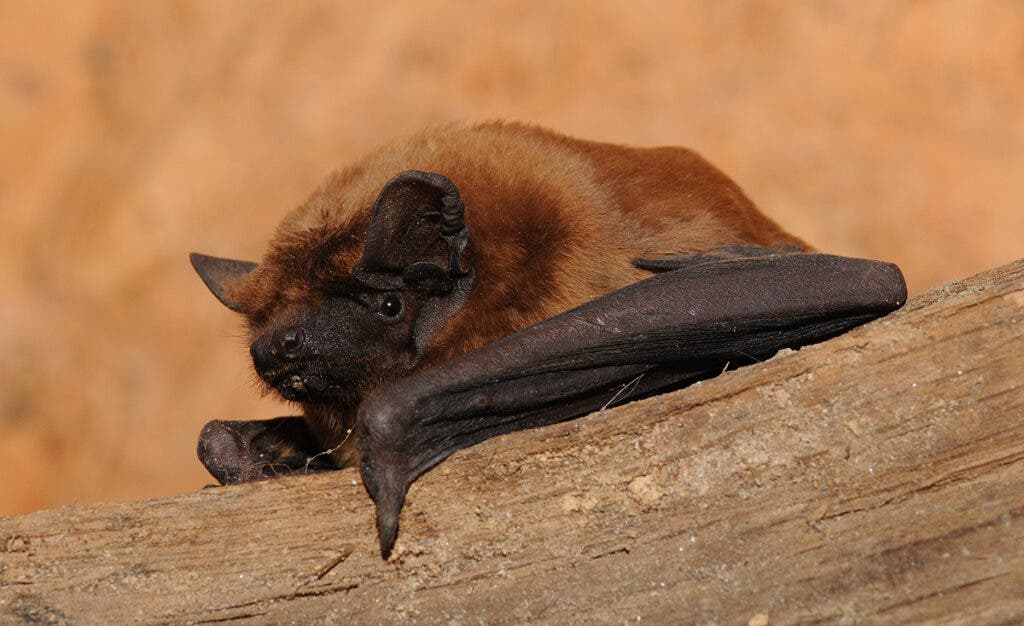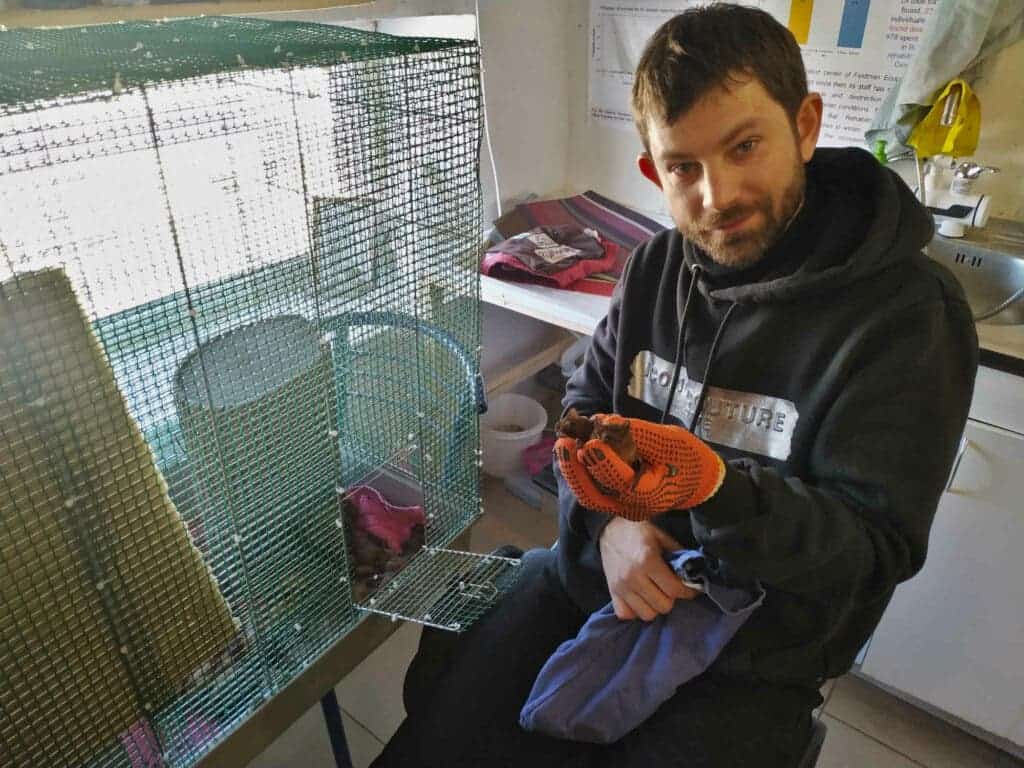
As Russian forces advanced this summer on Kharkiv, Ukraine’s second-largest city, the façade of an eight-story apartment building in the Saltivka district suffered heavy damages from shelling, as did many other multi-family structures. Dozens of bullets scarred the gray front wall, and most of the upper windows were shattered. By August, only a few families remained. Some noticed dozens of bats trapped in the lower windows. The animals had flown through broken panes of glass, then got stuck, unable to find an exit. Soon they were dying of dehydration and starvation.
But in a lucky turn of events, one of the families called the Ukrainian Bat Rehabilitation Center, an organization of biologists and veterinarians who rescue and treat injured bats. When Anton Vlaschenko, its director, and Lika But, a volunteer, arrived on the scene, they carefully removed the remaining animals, the majority of which were common noctules, or Nyctalus noctula. Eight of the bats were already dead. The remaining 18 they put inside a bag and took home. “We measured their body mass, fed them, watered, and released them in the evening,” said Vlaschenko.
His organization, established in 2013, has become the largest bat rescue and research facility in Eastern Europe. But the war changed everything. The center lost all its funding in February, and some of its staff and collaborators were drafted. And hundreds of trapped bats — which are a key part of the ecosystem — began dying in destroyed or abandoned buildings.
Making matters worse, the Russian Ministry of Defense accused the center and collaborating researchers from the Institute of Experimental and Clinical Veterinary Medicine in Kharkiv of developing bioweapons. On March 10, the Russian online newspaper Vzglyad accused them of working “in Pentagon biolaboratories” under the remote “supervision of specialists from the U.S.” to research bat parasites like mosquitos, lice, ticks, and fleas that “are able to spread dangerous infectious diseases.”
In fact, the center’s study of bat parasites was a side project developed with German researchers that, according to the abstract of a paper published in June 2021, aimed to “perform a molecular screening for selected vector-borne pathogens in ectoparasites collected from bats.” The goal, according to Vlaschenko and his team, was to find out which germs were able to jump from bats to other species, including humans.
On March 11, at a meeting of the U.N. Security Council, Russian Ambassador Vassily Nebenzia claimed that “bats were considered as carriers of potential bioweapons.” Yet later that day, speaking in New York, Izumi Nakamitsu, the U.N.’s high representative for disarmament affairs, said “The U.N. is not aware of any biological weapons program being conducted in Ukraine.”
Despite the accusations and frequent bombings, the center continued its bat rescue efforts throughout the spring and summer, and decided not to blur the faces of its members on rescue videos posted on its Facebook page. “If Russians really came to the city,” Vlaschenko said, “we would’ve been imprisoned and possibly tortured.”
As the war ground on, the center scrambled to save bats wherever it could. August, in particular, “was a crazy period,” said Vlaschenko. “The city was full of bats and each day we had two to four cases of bats trapped in flats or in windows. For a month we found nearly 3,000 bats, alive and dead, in Kharkiv.” He managed to keep the animals that required care in cages at his family’s apartment, as many as 40 at a time.
Even now, after Ukrainian forces launched a successful counteroffensive in September that resulted in the withdrawal of Russian troops from the Kharkiv area, Vlaschenko said that he and his colleagues are struggling to fulfill their mission: “We have three main directions of our activity: educating people about bats, scientific research, and bat rehabilitation.”
Despite their sinister reputation as nocturnal blood-suckers, European bats do not feed on blood and instead devour huge numbers of insects — moths, beetles, and mosquitoes — thus making them an essential component of the continent’s ecosystems.
According to the rehabilitation center’s website, there are 28 known bat species in Ukraine, 13 of which are found in the Kharkiv region. One of the organization’s main goals is educating the public. “Ordinary people do not care about bats in Ukraine,” he said.
Vlaschenko was intitially drawn to bats in the early 2000s as a zoology student at V.N. Karazin Kharkiv National University. “All of wildlife has to be rescued,” he said, noting the particular dangers bats face. During the winter the animals hibernate, and they need a place where the temperature is low but above the freezing point, often choosing cellars and attics, where they stay from late October through late March.
In Kharkiv, where winter temperatures stay below minus 4 degrees Fahrenheit for days, bats often freeze or die of starvation. As a student, whenever Vlaschenko heard of bats disturbed by construction work during cold months, he rushed to save them by bringing them to his apartment, where he fed, watered, and kept them until he could release them safely in the spring.
In 2013, with financial help from Oleksandr Feldman, a politician and one of the wealthiest men in Ukraine, Vlaschenko, along with two colleagues — Alona Prylutska and Ksenia Kravchenko — set up the Ukrainian Bat Rehabilitation Center in a park owned by Feldman north of Kharkiv. Called Feldman Ecopark, the place promotes itself as a mix of “animal care and therapy for children with special needs.”
In a forested area of Feldman Ecopark, they built something the researchers call a bat-collider, a 65-foot-long tunnel, 6 feet high and 6 feet wide, where bats can fly or hibernate. Each year, 1,000 to 3,000 rescued bats have wintered there, before their release in late March. In the late summer and early fall, the staff also cared for orphaned or injured bats and helped bats that got lost during migration. People from across Ukraine and Eastern Europe began sending them sick or injured bats.
During the heavy bombardment at the beginning of the war, the center’s staff hid in cellars and other underground shelters, as did most Ukrainian citizens. But people kept spotting hibernating bats. “We got a lot of calls even from soldiers who found bats in bunkers,” said Vlaschenko.
Initially, the staff lost access to the more than 1,000 animals hibernating in Feldman Ecopark, though they were able to place bats requiring more attention in private homes. In March, however, during the shelling of Kharkiv, the staff ventured back to the bat collider to release the bats waking up from hibernation. “We cannot provide details about our journey,” the center posted on its Facebook page, but it was “close to the frontline.” Most of the animals were in good condition, and they were able to free some 1,000 bats into the wild.

Until this year, the frozen carcasses of those bats too sick or injured beyond recovery were used for scientific research into areas like sexual dimorphism (the anatomical differences between males and females), skull shapes, pollution, and parasites. “They truly had a group of people who knew how to help bats, including those sick or injured,” said Ewa Komar, a bat scientist from Mammal Research Institute Polish Academy of Sciences in Białowieża, Poland, who was unable to find local veterinarians specializing in bats and turned to the Ukrainian team for guidance. “They developed very effective animal rehabilitation methods and shared them through a series of scientific publications and lectures at international conferences.”
Ryszard Laskowski, an ecotoxicologist from Jagiellonian University in Krakow, Poland, said Vlaschenko approached him a few years ago to offer to share his collection of frozen bats. “We have an excellent Ph.D. student from his group,” he said. “She studies contamination of bats checked if external tissues can be used to predict internal pollution with lead, copper, zinc, and cadmium.”

The student, Olha Timofieieva, published a study in 2021 that showed the usefulness of bats as a “bioindicator species,” in which the level of pollution in their systems can reflect environmental conditions. She also discovered that the fur and wing membrane in one bat species could be used to check the accumulation of lead inside the animal, allowing for non-invasive methods to measure their inner organs’ contamination.
“I admire these people,” said Laskowski. “After all, they risk their lives to save bats and scientific collections.”
Almost all the research and international collaboration abruptly stopped on Feb. 24, when Russia invaded Ukraine. A private Ukrainian foundation that sponsored the project was no longer able to provide support, leaving the center to rely on financing from abroad. “We got several grants 1,000 to 5,000 euros each from organizations like International Animal Rescue or International Fund for Animal Welfare,” said Vlaschenko.
Crucial support also came from neighboring Poland. “We had a lot of calls from rehabilitation centers in Poland — we can help you, we can take your bats abroad,” according to Vlaschenko. Laskowski said “we provided them with laboratory equipment like vials and scissors for dissection. Also, we supported them financially a little bit.”
“Last winter, the Polish Academy of Sciences, including our institute, prepared some job offers and accommodation for Ukrainian researchers,” Komar added. “We sent a proposal to people from Kharkiv. They declined.”
“We decided we are here, in Ukraine, and we are going to continue our project,” explained Vlaschenko.
In April, Kharkiv remained partially encircled by Russian troops. In June and July Russians destroyed some of its public buildings, as well as a bus station not far from the center’s office, killing 20 people, though none from the bat team. In August, when missiles hit two Kharkiv dormitories, another 25 people were killed and several dozen injured.
Though the success of the recent counteroffensive has relieved some of the pressure, civilians, including the center’s team, are still not allowed to return to the Feldman Ecopark area.
“Our message to people abroad is: we are here and we are going to resist,” said Vlaschenko. “We want to continue our scientific and conservation activities.”
Wojciech Mikołuszko is a Polish book author and science journalist. From 2010 to 2011, he was a fellow in the Knight Science Journalism Program at MIT.
This article was originally published on Undark. Read the original article.



